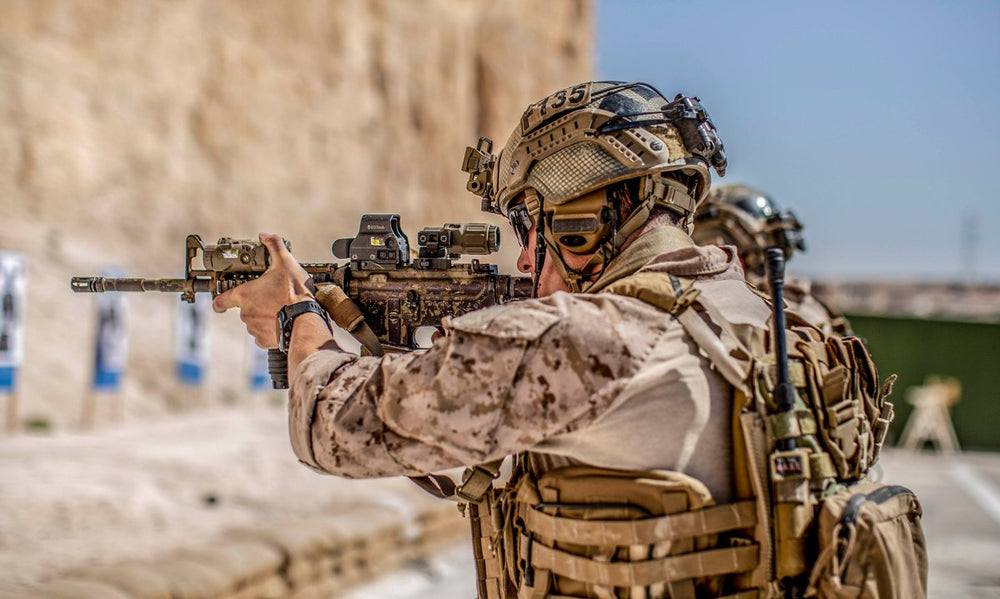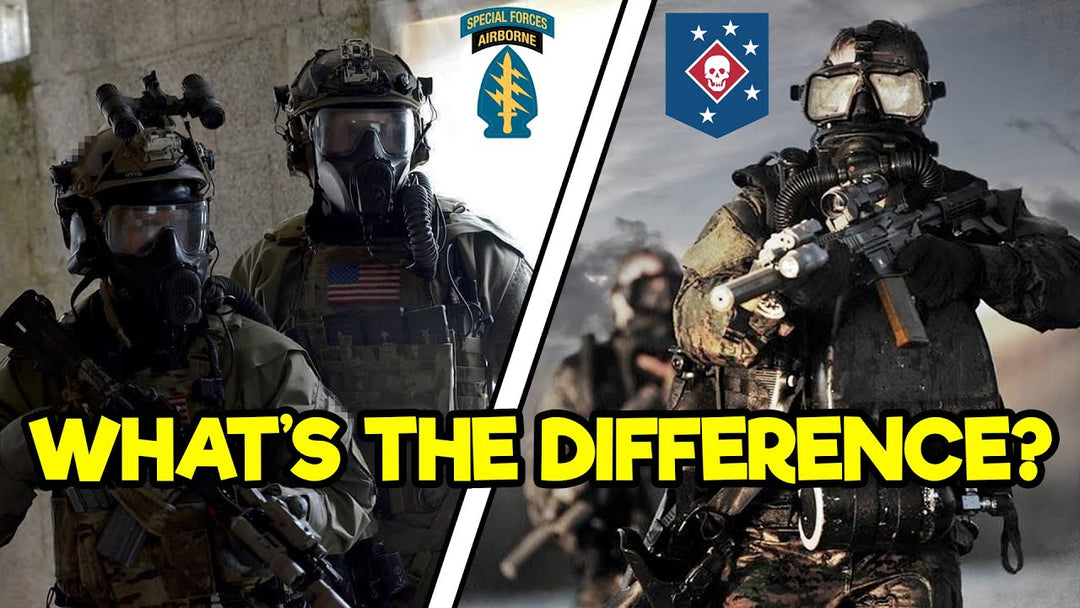U.S. Army 82nd Airborne Division vs. 101st Airborne Division: What’s the Difference?

The United States Army is home to a variety of legendary units with extensive histories on the battlefield. Two such units that stand out among the rest are the 82nd Airborne and 101st Airborne Divisions. While they may come from similar beginnings and share similar names, they have grown to be two entirely different and successful U.S. Army divisions.
With that said, what exactly do the 82nd and 101st Airborne Divisions do? Is one better than the other? What do they have in common? And most importantly, what makes them different?
We’re going to answer all of those questions for you, and much more.
This is 82nd Airborne Division vs. 101st Airborne Division.
TABLE OF CONTENTS
82nd vs. 101st AIRBORNE: 82nd HISTORY
82nd vs. 101st AIRBORNE: 101st HISTORY
82nd vs. 101st AIRBORNE: PRESENT DAY
82nd vs. 101st AIRBORNE: 82nd’s COMBAT ROLE
82nd vs. 101st AIRBORNE: 101st’s COMBAT ROLE
82nd vs. 101st AIRBORNE: ORGANIZATIONAL STRUCTURE
82nd vs. 101st AIRBORNE: TRAINING OVERVIEW
82nd vs. 101st AIRBORNE: 82nd’s TRAINING
82nd vs. 101st AIRBORNE: 101st’s TRAINING
82nd vs. 101st AIRBORNE: CONCLUSION
82nd vs. 101st AIRBORNE: 82nd HISTORY

The 82nd Airborne Division traces its roots all the way back to World War 1. Originally stood up as the 82nd Division in the National Army, the division contained soldiers from each of the 48 states, a very unique thing for the time. To boost unit morale during World War I, many of the Army divisions were making nicknames for themselves.
A contest was held to choose a nickname for the 82nd Division, and thousands of entries were submitted by the public. Out of the numerous entries, the winning choice came from Vivienne Goodwyn. She proposed the nickname 'The All American' Division, highlighting the fact that the division comprised soldiers from each state in the U.S. This moment marked the birth of the iconic "All American" Division shoulder sleeve patch, featuring a red square with a blue circle in the center. Over time, this patch would become one of the most widely recognized military symbols in the world.
Fast forward to World War 2, the U.S. Army adopted and developed the airborne concept, and the 82nd would be the first U.S. Army division to receive this designation, and from that point forward would be known as the 82nd Airborne Division.
The 82nd Airborne Division would play a vital role in World War 2, including D-day, Battle of the Bulge, and Operation Market Garden. These were some of the largest and most intense battles of the war.
Following World War 2 and into the early 1960s, the 82nd Airborne Division trained hard during the Cold War to become the nation’s Strategic Reaction Force. However, the 82nd did not participate in the Korean War, because both Truman and Eisenhower chose to keep the division in strategic reserve in the event of a Soviet ground attack anywhere in the world. Despite that, they would move on to be utilized in the Vietnam War, the Gulf War, and many of the major operations that took place after 9/11. Not only that, but they’d participate in Hurricane Katrina relief, and would deploy often to the Middle East. Even recently, they were present for the Kabul evacuation in 2021.
82nd vs. 101st AIRBORNE: 101st HISTORY

While the 82nd Airborne Division was the first of its kind during World War 2, it certainly wasn’t the only one. During the same month the 82nd Airborne Division was created, the U.S. Army would also stand up the 101st Airborne Division, also known as the “Screaming Eagles”. Although the 101st Airborne Division had no history on the battlefield, the unit was ready to get to work. The unit's first commander, Major General William C. Lee., famously said that the “101st has no history, but has a rendezvous with Destiny.” As a division, the 101st has never failed that prophecy.
The 101st Airborne would ferociously train for combat operations during World War 2 and be put to the test on D-day, where their pathfinders became the first Americans to set foot in occupied France. The division would play an integral part in the invasion of Normandy, and would later play key roles in Operation Market Garden and Battle of the Bulge. During the Battle of the Bulge, the 101st would be surrounded in Bastogne, and the Germans demanded immediate surrender. This is where Brigadier General McAuliffe made history with his classic reply, “Nuts!”
Following World War 2, the 101st was inactivated. Two decades later, the 101st was called upon again and would play an integral role in the Vietnam War. Fun fact: the 101st Airborne was nicknamed "The Chicken Men" by the Vietnamese during the Vietnam War because their Eagle insignia looked like a chicken to them.
In 1968, the 101st shed their parachutes in favor of helicopter-borne operations, earning a brand new designation: the 101st Airborne Division (Airmobile). However, because of a shift in structure and orientation, the division was re-designated as the 101st Airborne Division (Air Assault) in 1974, which is how it remains to this day.
Throughout the rest of the 20th century, the 101st would be involved in numerous operations in the Middle East. This would ramp up from the United States’ response to 9/11, all the way into the present day.
82nd vs. 101st AIRBORNE: PRESENT DAY

While the 82nd and 101st Airborne divisions might share similar names, present day, they are two completely different units. For starters, the 82nd Airborne is a true airborne division. What do we mean by that? Well, the 82nd Airborne conducts actual, frequent airborne jumps, meaning jumping out of planes, and trains on airfield seizures. This is different from the 101st, which despite having the word “Airborne” in its name, is not actually a true airborne division. It is an Air Assault division, meaning their soldiers rappel out of helicopters when inserted into a particular area of operations. Despite their differences, both are very elite, have large budgets, and rapidly deploy.
82nd vs. 101st AIRBORNE: 82nd’s COMBAT ROLE

Taking a deeper dive into things, the 82nd Airborne is an airborne infantry division specially trained and equipped to leapfrog enemy lines and establish an “entry point” for advancing ground forces. The 82nd is one of the largest and most frequently deployed combat units in the U.S. Army. It can mobilize, load, and land anywhere in the world in less than 36 hours to perform combat operations, assist U.S. allies, and provide humanitarian assistance. Its soldiers can be distinguished from other military service members by their maroon berets. Fun fact: even though the main separator between the 82nd and 101st is air assault capabilities, the 82nd does conduct some air assault missions from time to time.
82nd vs. 101st AIRBORNE: 101st’s COMBAT ROLE

But again, air assault is the 101st’s bread and butter. So much so that the 101st Airborne Division is the only air assault division of the U.S. Army. It provides an unmatched expeditionary Air Assault capability to conduct forcible entry and other worldwide unified land operations in support of combatant commanders. Its Combat Aviation Brigade, which is home to its aircraft, is the most decorated aviation unit in the U.S. Army. They’ve flown hundreds of thousands of hours transporting millions of troops, and hold a record for the longest air assault in history.
82nd vs. 101st AIRBORNE: ORGANIZATIONAL STRUCTURE

Both the 82nd and 101st are broken down into Brigade Combat Teams, which is the basic deployable unit of maneuver in the U.S. Army. Looking at things at a high level, they are both structured to have a headquarters element, three brigade combat teams, a combat aviation brigade, and a sustainment brigade.
Additionally, both the 82nd and 101st Airborne Divisions consist of a multitude of soldiers from a variety of backgrounds and MOSs. Unlike other units, such as the 75th Ranger Regiment, there isn’t a direct pipeline to these divisions. Instead, soldiers who are assigned to these typically attend U.S. Army Airborne School or the U.S. Army Air Assault Course.
82nd vs. 101st AIRBORNE: TRAINING OVERVIEW

The training required for someone to join the 82nd or 101st Airborne Divisions mainly boils down to the two schools we mentioned moments ago, the U.S. Army Airborne School and Air Assault Course. Soldiers have the flexibility to join these divisions at any stage in their military careers. This means that these schools can be completed right after someone finishes their initial military training, or they can be pursued later in their military career, even after several years of service.
82nd vs. 101st AIRBORNE: 82nd’s TRAINING

To join the 82nd Airborne Division, soldiers typically need to complete the Basic Airborne Course at the Airborne School. This course, also known as jump school, lasts for three weeks and is located at Fort Moore, Georgia. The primary aim of jump school is to train students in using parachutes for combat deployment and to foster leadership, self-confidence, and an aggressive spirit through both mental and physical conditioning.
Service members from various ranks and branches of the military can attend this school to earn their jump wings. The three-week course is divided into three distinct training phases: Ground Week, Tower Week, and Jump Week. These phases are structured in a way that resembles a gradual progression from basic to advanced training, similar to a crawl, walk, run approach.
Ground Week focuses on building individual airborne skills and includes training on the mock door, the 34-foot tower, and the lateral drift apparatus. In Tower Week, individual skills are refined, and team efforts are introduced, with training on various apparatus such as the swing landing trainer and the 34-foot towers. Jump Week involves five parachute jumps from an aircraft, with some jumps including combat equipment and a night jump to provide a comprehensive understanding of airborne operations.
82nd vs. 101st AIRBORNE: 101st’s TRAINING

To join the 101st Airborne Division, soldiers typically need to complete the Air Assault Course. The Air Assault course is held at several locations and is ten days long. Some have called the Air Assault course “the ten toughest days in the Army” but we’ll leave that for the reader to decide.
The Air Assault Course is separated into three phases: Combat Assault Phase, Sling Load Phase, and the Rappelling Phase.
In the Combat Assault Phase, soldiers are trained in various skills such as Aircraft Safety, Aero Medical Evacuations, and Pathfinder Operations. They undergo two academic tests and conduct various physical training events.
In the Sling Load Phase, soldiers are instructed on the preparation, rigging, and inspection of various loads, including equipment like the M119 105mm Howitzer, M998 HMMWV, Shotgun configuration, and more. They will undergo two academic tests, and among others, will be tested on a 6-mile ruck march.
In the Rappelling Phase, soldiers are instructed in tasks like tying the Swiss rappel seat, hook-up techniques, lock-in procedures, combat rappelling, and belay procedures. They perform multiple rappels from different locations, including the side of a 34-foot tower and a UH-60 Blackhawk helicopter, both with and without equipment.
The course culminates with a 12-mile ruck march, which soldiers must complete with the prescribed uniform and equipment in three hours or less. If soldiers can’t keep up or do not have all of the items on the packing list, they will not graduate with their class.
Needless to say, it’s no walk in the park to join the 82nd and 101st Airborne Divisions. Both of these elite Army units have contributed to the U.S. Military’s success time and time again, and will likely continue on with their legacy doing just that.
CONCLUSION


The 82nd and 101st Airborne Divisions are the tip of the iceberg when it comes to elite U.S. Army units. If you’re interested in learning more about some of them, we’ve done a blog post covering every U.S. Army Special Operations unit.
If you’re wanting to learn more about the military, law enforcement, or government entities, we have a YouTube channel dedicated to providing the best info out there, plus we have a growing list of blog posts as well. Click the links to take you to them!
General Discharge is a veteran owned, veteran operated organization that is dedicated to providing the best U.S. Military and Law Enforcement information. With over 250 YouTube videos, over 45 million views, and hundreds of thousands of followers, we have contributed to the success and knowledge of both the current and future generation of service members.






Served in 82nd Airborne 1963-1965 All the way. Both these Divisions are very elite and outstanding, so proud to have served
Leave a comment